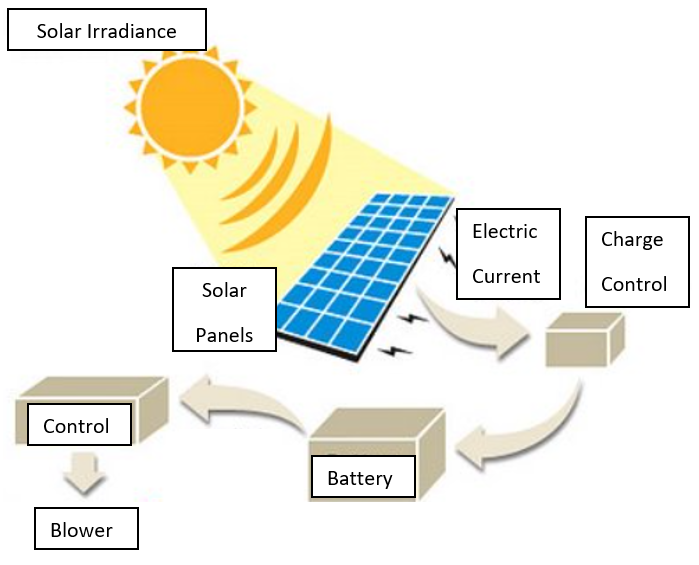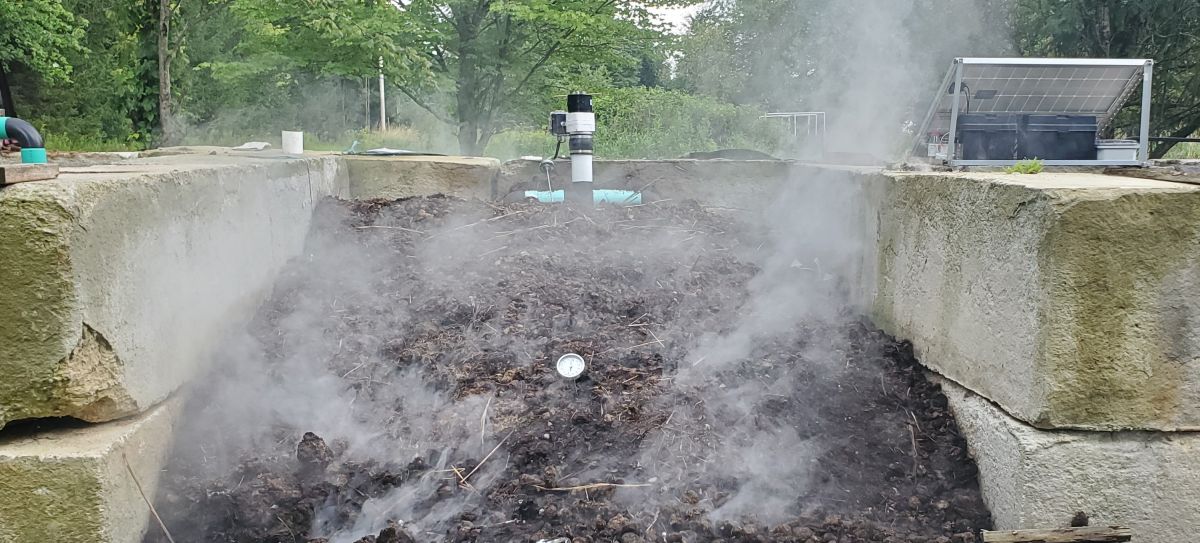Solar Option
 Solar Powered System
Solar Powered System
- For those with no on-site power or those who want to operate off-the-grid.
- Design utilizes marine grade products, components and wiring for a long service life.
- No inverter is necessary as the blower and blower control is direct current (DC) not alternating current (AC).
- Two solar panels provide for rapid recharging of the batteries even in the winter months of lessened daylight hours.
- Marine grade 12-volt, deep cycle batteries alone supply power during nighttime and heavy snow periods for round-the-clock aeration.
- The autonomic period is dependent upon the duty-cycle.
- Should batteries become depleted, the controller will automatically switch off the blower load until solar panels can recharge the batteries to their designed voltage. The system automatically restarts.
- An optional cellular module can permit remote monitoring from anywhere a web connection is avalaible.
Below is seen a solar powered Dungter at a farm in Crawfold County PA. The solar panels are seen on the far right. Tucked in below the panels are the batteries and the solar controller. The DC blower is seen at the back of the bunker on the veritcal infeed manifold. All these items are portable and can be re-positioned as the concrete bunkers alternate between filling, composting and storage.
Solar Powered Composters Earn Federal Solar Tax Credit
Inflation Reduction Act of 2022 extends Federal Solar Tax Credit
The US Federal Government offers a solar energy residential tax credit, known as the Solar Investment Tax Credit (ITC), and is applicable to your first/second home, including your farm/ranch! If there are living facilities your farm will qualify. The Credits were due to expire but the Inflation Reduction Act of 2022 has extended it for a further 10 years.
Who Can Take the Credit? You may be able to take the credit if you made energy saving improvements to your home located in the United States in 2022. A home is where you lived in 2022 and can include a house, houseboat, mobile home, cooperative apartment, condominium, and a farm....the home does not have to be your main home.
In 2022 and beyond to 2032 this tax credit is at 30% on the total system cost of all qualified expenditures: this can include solar panels, charge controllers, inverters, wiring, batteries, parts, and labor. This credit can be retroactive, so long as the solar system was placed into service after January 1, 2006. (Disclaimer: As always, please consult with your tax advisor or accountant for the most up to date tax info for your situation.)
It is easy to file! Step 1: Complete IRS Form 5695. Be sure to check you use the latest version of the form which is updated January/February each year (note: the above forms are for 2020) www.irs.gov/pub/irs-pdf/f5695.pdf
For instructions on how to complete Form 5695 download the instructions here www.irs.gov/pub/irs-pdf/i5695.pdf
Step 2: Once IRS Form 5695 is completed it gives a total that is then entered as a line item on IRS Form 1040. The two forms are then attached together and filed at the same time as your IRS Form 1040. https://www.irs.gov/pub/irs-pdf/f1040.pdf
If you cannot use all the credit because of the tax liability limit (that is, line 14 is less than line 13), you can carry the unused portion of the credit forward to the next year.
Federal Investment Tax Credit (ITC) Phase Out Dates and Details
Tax Credit on total system cost, placed in service:
Jan. 1, 2022 - Dec. 31, 2032 = 30% tax credit
Jan. 1, 2033 - Dec. 31, 2033 = 26% tax credit
Jan. 1, 2034 - Dec. 31, 2034 = 22% tax credit
After Jan. 1, 2035 = 0% tax credit

The most economical way to turn horse manure into compost Dumpster Kits avaiable for purchase or rental